#Assassination of Lord Louis Mountbatten
Text
#OTD in Irish History | 27 August:
1695 – The second Irish parliament of William III is called in Dublin; Robert Rochfort is unanimously elected Speaker.
1798 – General Humbert appears outside Castlebar. The Government forces are deployed to cover the direct route and Humbert unexpectedly appears on their flank. Humbert attacks. French advance causes Militia to run. Government defence collapses and Humbert takes the town.…
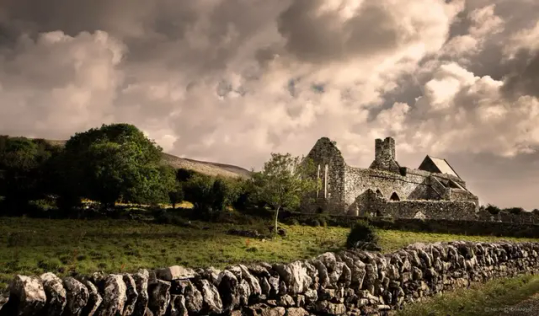
View On WordPress
#irelandinspires#irishhistory#OTD#1798 United Irishmen Rebellion#27 August#Assassination of Lord Louis Mountbatten#Co. Clare#Corcomroe Abbey#History#History of Ireland#Ireland#Irish Civil War#Irish History#Irish War of Independence#John Henry (JH) Foley#MK Photography#Northern Ireland#Seán Purcell#The Master#Today in Irish History#Warrenpoint Massacre
16 notes
·
View notes
Text
youtube
The Queen's Historic Visit to Northern Ireland (1977)
In August 1977, Queen Elizabeth II visited Northern Ireland as part of her Silver Jubilee Tour of the United Kingdom. Travelling with Prince Philip, Duke of Edinburgh and Prince Andrew, Duke of York, it was the first time in 11 years the Queen had visited Northern Ireland, due to the security risk posed by the ongoing Troubles. The Provisional IRA’s ongoing military campaign against Britain included the targetting of senior members of the British state, including the Royal Family. Two years to the month after the Queen’s visit to Ulster, Lord Louis Mountbatten – the great uncle of Prince Charles – was assassinated by a Provisional IRA bomb in County Sligo. This 30-minute programme aired on the second day of her trip, 11 August, and covers the Queen’s visit to Ulster University in Coleraine, where she made a powerful speech referencing the country's turbulent present and its hopes for the future.
25 notes
·
View notes
Text

"Classiebawn Castle, County Sligo". Image credit: - 📸 @dublinsnap
Classiebawn castle close to the head of Mullaghmore on County Sligo’s Wild Atlantic Way, was the holiday home of Louis Mountbatten, a member of the British royal family who was assassinated close by in 1979. The pair of standing stones erected on the ground below the castle would seem to support the reputed occult interests of Lords Palmerston, Ashley and Mountbatten.
Classiebawn Castle is a country house built for The 3rd Viscount Palmerston (1784–1865) on what was formerly a 10,000-acre (4,000 ha) estate on the Mullaghmore peninsula near the village of Cliffoney, County Sligo, in the Republic of Ireland. The current castle was largely built in the late 19th century.
This piece is taken from the privately published guidebook to Classiebawn Castle by Lord Louis Mounbatten.
The first site chosen was on nearby Dernish Island but after several attempts it was found impossible to build a causeway from the mainland to the island owing to the heavy tides running.
The present site was then chosen and the building of the Castle started. The architect of the Castle was J Rawson Carroll, F. R. I. A. Lord Palmerston also built the Harbour at Mullaghmore, and a row of fishermen’s cottages on the hill overlooking the harbour. At that time the estate exceeded 6000 acres and included the whole of the Mullaghmore Peninsula.
> Love Ireland
1 note
·
View note
Text
CBC THE ROYAL FASCINATOR

Friday, November 20, 2020
Hello, royal watchers and all those intrigued by what’s going on inside the House of Windsor. This is your biweekly dose of royal news and analysis.
Reading this online? Sign up here to get this delivered to your inbox.

Janet DavisonRoyal Expert
Fact, fiction and The Crown

The last time Arthur Edwards took a photo of Prince Charles with Lord Louis Mountbatten, the heir to the throne had his arm around his great uncle. Similarly, Mountbatten had his arm around his great-nephew.
They both seemed to be in fine form that day, not too long before Mountbatten lost his life to an IRA bomb in the summer of 1979 off the coast of Ireland.
"They were laughing together," Edwards, the longtime royal photographer for the Sun newspaper, recalled over the phone from the U.K. this week.
The recollection came to mind as controversy swirls over the newly released Season 4 of the Netflix drama The Crown.
The show takes viewers into the reign of Queen Elizabeth, with the latest season moving the action into the 1980s. In the first episode, Mountbatten is seen just before his assassination writing a letter to Charles saying he could bring "ruin and disappointment" on the Royal Family with his pursuit of Camilla Parker Bowles, who in real life is now Charles's wife but at that time was married to someone else.
There's no evidence — again, in real life — that such a letter was ever written or that Charles and Mountbatten quarrelled before he was killed.
It's just one of many moments in the latest season that have set off debate over how fact meets fiction in the award-winning drama created by Peter Morgan.
"Many people will think it's the truth ... but it's not," said Edwards, who snapped his first photo of Charles feeding sugar to his polo ponies in the mid-1970s, just after he'd left the Royal Navy.
"Much of it … comes out of a scriptwriter's brain, which I can understand because … it's drama.”
What bothers Edwards, he said, is the portrayal of Charles.
"I've worked with him now for over 40 years, and I don't recognize that man in it."
And therein lies a challenge of turning history into drama.
"Certainly, in every season [of The Crown], there's a blend of fact and fiction, but it stands out in Season 4 because we are getting closer to the present day," said Toronto-based royal historian and author Carolyn Harris.
Because so many in the audience will have their own memories of how what is portrayed in Season 4 turned out in real life — how Charles's marriage to Diana, Princess of Wales, collapsed in spectacular fashion, for example — there is perhaps further potential for the controversy now swirling.
"It's always a challenge with historical fiction that the people who are being portrayed do not know what's going to happen next, but the audience ... does," said Harris.
In some instances, the episodes present events that played out in the public eye and reflect the historical record.
"An example is that engagement interview where Prince Charles famously said, 'whatever in love means,'" said Harris.
But there are many other examples of events being fictionalized or put together to create a narrative.
Take Michael Fagan's break-in at Buckingham Palace, a focus of Episode 5. That actually happened, in 1982. He breached security and made it to the Queen's bedroom, where he spoke to her.
"But Michael Fagan describes it as a very brief conversation before he was arrested, whereas for the purposes of the series, he has a more extended dialogue about [Prime Minister] Margaret Thatcher's politics in order to tie this event to the series's critique of political developments while [she] was prime minister," said Harris.
CBC Archives: The leadership fracas that forced Margaret Thatcher from power
Edwards worries, however, that people will believe The Crown's version of what happened when Fagan broke into the palace that night, which isn’t true, with its portrayal of a longer chat with the Queen.
"That's what really irritates me," he said.
And he remains troubled by the thought that the portrayal of Charles, pilloried for a bad marriage, doesn't reflect the driven and hard-working man he has seen up close, whether he is visiting and offering support to schoolgirls in northern Nigeria or the Jewish community in Krakow, Poland.
"You won't see that on Netflix."
Edwards went with Charles when he returned in 2015 to the site of Mountbatten's assassination.
"I watched him … and he was remembering it."
As aware as Edwards is of The Crown, he has stopped watching it.
"You've got to remember it's drama; it's not necessarily the whole truth."
Just let loose and dance
Peter Morgan may be the creative mind behind The Crown, but in the current season, at least one moment playing out on the small screen came straight from the actor.
At one point, Diana — played by Emma Corrin — dances by herself with wild abandon inside a very well-appointed room at Buckingham Palace — or in this case, a stately home filling the role of the palace where Diana went to live after her engagement to Prince Charles was announced in 1981.
"It was one of my favourite scenes to film," Corrin said in a recent interview with the Royal Fascinator.
"I loved it because they wanted to choreograph it, and I said, 'Do you mind if we don't ... I don't think we can choreograph a moment like that. I'd love to just let loose and dance.'"
So she did, and she chose the song that was blasting over the speakers during filming, a bit of musical time travel to 1998, and Cher's Believe.
Corrin's love for the song dates back a few years.
"There's a theatre company in Britain called DV8, and they do this show called The Cost of Living, and there's an amazing dance scene," she said. "A guy does this dance to Cher's … Believe…. It's like the truest form of expression I've seen."
In Corrin's research for the role, she was surprised to learn how important dance was for Diana.
"It was quite a private thing," said Corrin. "You see her dancing and what that does, how that is such a mode of expression and release, and I thought that was really interesting."
Looking ahead — and looking back
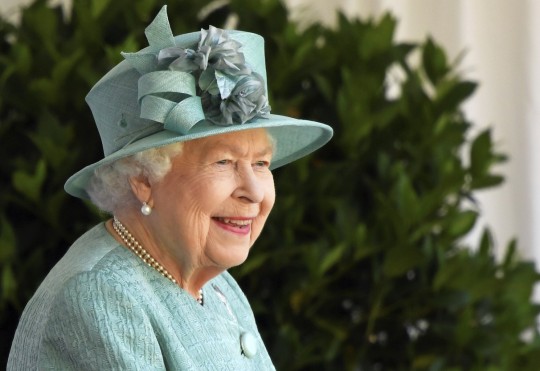
Every so often over the past few years, there have been rumblings about whether Queen Elizabeth, now 94, might step aside from her role as she gets older.
And as soon as those rumblings emerge, other royal observers are quick to note how that is unlikely for a variety of reasons, including the dark shadow cast by her uncle's abdication as King Edward VIII in 1936, her deep devotion to duty and how she has always considered her role as one for life.
So it wasn't too surprising to see that scenario play out again in recent days when one royal biographer suggested Elizabeth might "step down" when she turns 95 next April.
But soon after, there was also a very strong signal from Buckingham Palace about looking ahead in her reign.
The first plans were announced for celebrations in 2022 to mark her Platinum Jubilee, or 70 years on the throne. It would be an unprecedented milestone — no British monarch has reigned as long as she has. In the United Kingdom, it will culminate in a four-day bank holiday weekend in early June.
Oliver Dowden, the British culture secretary, said it would be a "truly historic moment" worthy of a "celebration to remember," the BBC reported.
Royally quotable
"Let us reflect on all that we have been through together and all that we have learned. Let us remember all victims of war, tyranny and persecution; those who laid down their lives for the freedoms we cherish; and those who struggle for these freedoms to this day."
— Prince Charles,
during a visit to Germany
to attend events commemorating its national day of mourning, which focused on British-German relations this year.
Royals in Canada

While members of the Royal Family have made numerous trips to Canada over the years, The Crown hasn't turned its dramatic attention to them yet, even though the show has featured several foreign visits.
"It's a shame," said royal historian Harris, because during Queen Elizabeth's reign, "there have been some very interesting Canadian tours."
Sure, there's been a brief glimpse of a Canadian flag at a table during a Commonwealth Heads of Government Meeting portrayed in The Crown.
"But we don't see Canada assuming a prominent role, whereas the series has had at least three tours of Australia," Harris said.
One episode in the current Season 4 focuses on Charles and Diana's 1983 trip Down Under. Shortly after that visit, Charles and Diana came to Canada. Had that been portrayed in The Crown, it would have backed up a developing theme, Harris said.
During the visit, Diana celebrated her 22nd birthday on Canada Day.
"There's press footage of Canadians giving Charles birthday cards to give to Diana, and a scene like that would have supported the theme of that episode of Charles feeling overshadowed by Diana," said Harris.
Edwards, the Sun photographer, was along for that trip, and has been to Canada about 15 times with members of the Royal Family.
The 1983 trip lasted 17 days and was "fantastic," he said. "It was just brilliant. I can recall it like it was yesterday. We criss-crossed the country."
During the opening of the World University Games in Edmonton on July 1, the crowd sang Happy Birthday to Diana.
"The whole crowd. It was phenomenal," said Edwards.
Harris sees potential plotting for future seasons of The Crown possibly playing into how the series has portrayed foreign visits so far.
"We see a stronger Australia focus, and it's certainly possible that the 1999 Australian referendum [on the monarchy] may come up in a subsequent season so some of this may be building towards that.
"But definitely in terms of the Commonwealth, certain nations are emphasized more than others in the series."
Royal reads
1. Queen Elizabeth and Prince Philip
celebrated their 73rd wedding anniversary today
, and a photo was released of them reading a card from their great-grandchildren. [CBC]
2. In a rare statement, Prince William has said he
welcomes an investigation by the BBC
into circumstances around the controversial Panorama interview his mother, Diana, Princess of Wales, gave to Martin Bashir in 1995. [CBC]
3. Meghan, Duchess of Sussex,
did authorize a friend to talk to the authors of Finding Freedom
, a biography of her and Prince Harry that was published his summer, court papers say. [ITV]
Cheers!
I’m always happy to hear from you. Send your ideas, comments, feedback and notes to
. Problems with the newsletter? Please let me know about any typos, errors or glitches.
GSTQAOBC 🇨🇦🇬🇧🇦🇺🇳🇿
27 notes
·
View notes
Text
Events 8.27
410 – The sacking of Rome by the Visigoths ends after three days.
1172 – Henry the Young King and Margaret of France are crowned junior king and queen of England.
1557 – The Battle of St. Quentin results in Emmanuel Philibert becoming Duke of Savoy.
1593 – Pierre Barrière failed an attempt to assassinate Henry IV of France.
1689 – The Treaty of Nerchinsk is signed by Russia and the Qing Empire (Julian calendar).
1776 – Battle of Long Island: In what is now Brooklyn, New York, British forces under General William Howe defeat Americans under General George Washington.
1793 – French Revolutionary Wars: The city of Toulon revolts against the French Republic and admits the British and Spanish fleets to seize its port, leading to the Siege of Toulon by French Revolutionary forces.
1798 – Wolfe Tone's United Irish and French forces clash with the British Army in the Battle of Castlebar, part of the Irish Rebellion of 1798, resulting in the creation of the French puppet Republic of Connacht.
1810 – Napoleonic Wars: The French Navy defeats the British Royal Navy, preventing them from taking the harbour of Grand Port on Île de France.
1813 – French Emperor Napoleon I defeats a larger force of Austrians, Russians, and Prussians at the Battle of Dresden.
1828 – Brazil and Argentina recognize the sovereignty of Uruguay in the Treaty of Montevideo
1832 – Black Hawk, leader of the Sauk tribe of Native Americans, surrenders to U.S. authorities, ending the Black Hawk War.
1859 – Petroleum is discovered in Titusville, Pennsylvania leading to the world's first commercially successful oil well.
1881 – The Georgia hurricane makes landfall near Savannah, Georgia, resulting in an estimated 700 deaths.
1883 – Eruption of Krakatoa: Four enormous explosions almost completely destroy the island of Krakatoa and cause years of climate change.
1893 – The Sea Islands hurricane strikes the United States near Savannah, Georgia, killing between 1,000 and 2,000 people.
1896 – Anglo-Zanzibar War: The shortest war in world history (09:02 to 09:40), between the United Kingdom and Zanzibar.
1914 – World War I: Battle of Étreux: A British rearguard action by the Royal Munster Fusiliers during the Great Retreat.
1915 – Attempted assassination of Bishop Patrick Heffron, bishop of the Diocese of Winona by Rev. Louis M. Lesches.
1916 – World War I: The Kingdom of Romania declares war on Austria-Hungary, entering the war as one of the Allied nations.
1918 – Mexican Revolution: Battle of Ambos Nogales: U.S. Army forces skirmish against Mexican Carrancistas in the only battle of World War I fought on American soil.
1922 – Greco-Turkish War: The Turkish army takes the Aegean city of Afyonkarahisar from the Kingdom of Greece.
1927 – Five Canadian women file a petition to the Supreme Court of Canada, asking, "Does the word 'Persons' in Section 24 of the British North America Act, 1867, include female persons?"
1928 – The Kellogg–Briand Pact outlawing war is signed by fifteen nations. Ultimately sixty-one nations will sign it.
1933 – The first Afrikaans Bible is introduced during a Bible Festival in Bloemfontein.
1939 – First flight of the turbojet-powered Heinkel He 178, the world's first jet aircraft.
1942 – First day of the Sarny Massacre, perpetrated by Germans and Ukrainians.
1943 – World War II: Japanese forces evacuate New Georgia Island in the Pacific Theater of Operations during World War II.
1943 – World War II: Aerial bombardment by the Luftwaffe razes to the ground the village of Vorizia in Crete.
1955 – The first edition of the Guinness Book of Records is published in Great Britain.
1956 – The nuclear power station at Calder Hall in the United Kingdom was connected to the national power grid becoming the world's first commercial nuclear power station to generate electricity on an industrial scale.
1962 – The Mariner 2 unmanned space mission is launched to Venus by NASA.
1963 – An explosion at the Cane Creek potash mine near Moab, Utah kills 18 miners.
1964 – South Vietnamese junta leader Nguyễn Khánh enters into a triumvirate power-sharing arrangement with rival generals Trần Thiện Khiêm and Dương Văn Minh, who had both been involved in plots to unseat Khánh.
1971 – An attempted coup d'état fails in the African nation of Chad. The Government of Chad accuses Egypt of playing a role in the attempt and breaks off diplomatic relations.
1975 – The Governor of Portuguese Timor abandons its capital, Dili, and flees to Atauro Island, leaving control to a rebel group.
1979 – The Troubles: Eighteen British soldiers are killed in an ambush by the Provisional Irish Republican Army near Warrenpoint, Northern Ireland, in the deadliest attack on British forces during Operation Banner. An IRA bomb also kills British royal family member Lord Mountbatten and three others on his boat at Mullaghmore, Republic of Ireland.
1980 – A massive bomb planted by extortionist John Birges explodes at Harvey's Resort Hotel in Stateline, Nevada after a failed disarming attempt by the FBI. Although the hotel is damaged, no one is injured.
1982 – Turkish military diplomat Colonel Atilla Altıkat is shot and killed in Ottawa. Justice Commandos of the Armenian Genocide claim to be avenging the massacre of 11⁄2 million Armenians in the 1915 Armenian genocide.
1985 – Nigeria's military government is overthrown by another clique of army officers.
1991 – The European Community recognizes the independence of the Baltic states of Estonia, Latvia and Lithuania.
1991 – Moldova declares independence from the USSR.
2003 – Mars makes its closest approach to Earth in nearly 60,000 years, passing 34,646,418 miles (55,758,005 km) distant.
2003 – The first six-party talks, involving South and North Korea, the United States, China, Japan and Russia, convene to find a peaceful resolution to the security concerns of the North Korean nuclear weapons program.
2006 – Comair Flight 5191 crashes on takeoff from Blue Grass Airport in Lexington, Kentucky bound for Hartsfield–Jackson Atlanta International Airport in Atlanta. Of the passengers and crew, 49 of 50 are confirmed dead in the hours following the crash.
2009 – Internal conflict in Myanmar: The Burmese military junta and ethnic armies begin three days of violent clashes in the Kokang Special Region.
2011 – Hurricane Irene strikes the United States east coast, killing 47 and causing an estimated $15.6 billion in damage.
2 notes
·
View notes
Photo


Edwina and I spent all our married lives getting into other people's beds.
- Lord Louis Montbatten
In 1922, a royal but impoverished naval officer called Louis Mountbatten proposed to a fabulously wealthy woman called Edwina Ashley in Delhi. Both in their early 20s, they had known each other only a few months, but were determined to spend their lives together. The day after Edwina accepted, her fiancé diarised how they had “motored out to King Humayun’s enormous tomb, which we saw at 3am by moonlight". It was all “wonderful and romantic", and, a month later, they made another trip to the 16th century mausoleum. This time, however, the bride-to-be was less impressed. “Edwina having just…seen the Taj Mahal," wrote Mountbatten, “was full of scorn for this poor little tomb."
In some respects the episode was a pithy description of their marriage years that lay ahead. In his new biography The Mountbattens: Their Lives and Loves, British historian Andrew Lownie has claimed that the late Lord Mountbatten and his wife Edwina spent their married lives engaging in a stream of affairs. Lownie relates how the last viceroy of India, who was assassinated in 1979 by an IRA bomb aged 79, was initially devastated by wife Edwina's affairs but came to terms with his wife’s hedonistic flings as he struggled with his bisexual impulses.
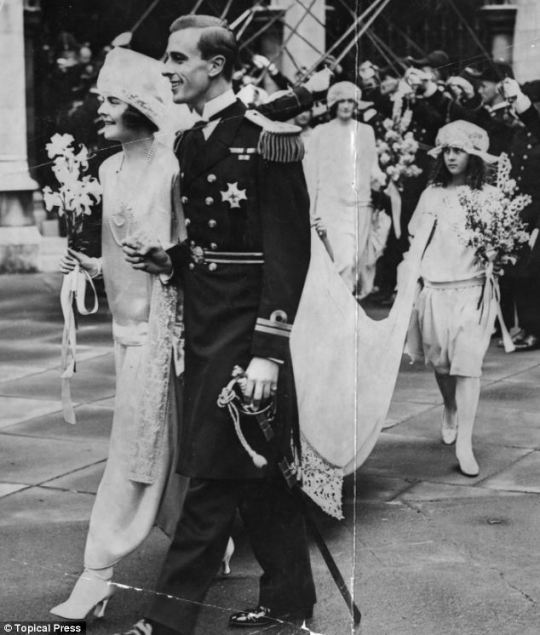
After a fumbling honeymoon, some of it spent in Hollywood, Mountbatten resumed his career as a naval officer.
Meanwhile, the stylish Edwina, described as one of the six best- dressed women in the world, shopped at Chanel, played bridge, and danced the Charleston until 3am, sometimes with Fred Astaire.
Edwina was also inordinately put out when — after ten years of her undisguised infidelities — he took a long-term lover of his own, the sparky, boyish Yola from France (on whom, claims Pamela, the novelist Colette based her fictional femme fatale, Gigi).
Mountbatten found ‘some contentment’ with Yola, as now did Edwina with a lover who became a permanent fixture in her life — ‘Bunny’ Phillips, a ‘thrillingly handsome’ (the words of their daughter Pamela) colonel in the Coldstream Guards.
On the surface, Edwina and her husband, Lord Louis Mountbatten, were the glitziest couple of their day — rich, high-born, debonair, de luxe. Beneath, the reality were separate beds, separate lives and a flurry of flings that set tongues wagging.
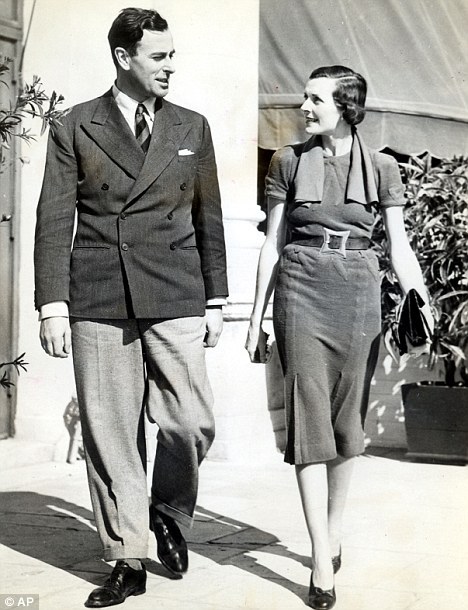
All their social gadding about came to a halt when war broke out in 1939. Mountbatten and Bunny Philliips had serious and all-consuming duties to perform for King and Country; Yola was trapped in enemy-occupied France.
And Edwina at last had something real to do. She put on a uniform and cap — albeit set at a jaunty, come-on angle — and threw herself, body and soul, into work with the St John Ambulance Brigade.
Pamela recalls her father looking at his wayward wife with a new sense of pride that she had at last found her purpose in life. Pamela felt the same when she saw her mother in action.
With the war over, Mountbatten was sent there to oversee the sub-continent gaining independence from British rule. His wife went with him and her charm was put to vital use in what the new Viceroy termed Operation Seduction — trying to bring the warring religious communities together.
She worked like a Trojan. Pamela, who went with them — for the first time finding herself at the very heart of the family with a distinct role to play — marvelled at her mother’s stamina and bravery, her ability ‘to forge through the heat of the day, impervious to physical hardship’. She was selfless and tireless, with a sensitivity to the suffering of others that made her a heroine in what was an increasingly volcanic and violent situation.
Edwina fell madly in love with India and its people. Of course tongues wagged at her close relationship with Indian nationalist leader Jawaharlal Nehru and India’s first post-independence Prime Minister.
In later years, their daughter Pamela would pore over Nehru’s letters to her mother, ‘and I came to realise how deeply he and my mother loved each other.’
But it was a spiritual and intellectual relationship, not a sexual one. Pamela is convinced of that. ‘Neither had time to indulge in a physical affair, and anyway the very public nature of their lives meant they were rarely alone.’ It seems Edwina had found her spiritual and intellectual match in the Harrow and Cambridge educated Nehru. ‘Dickie’ Mountbatten wisely gave his wife a wide berth as he increasingly came to terms with his own struggle with his bisexual feelings for young men in uniform.
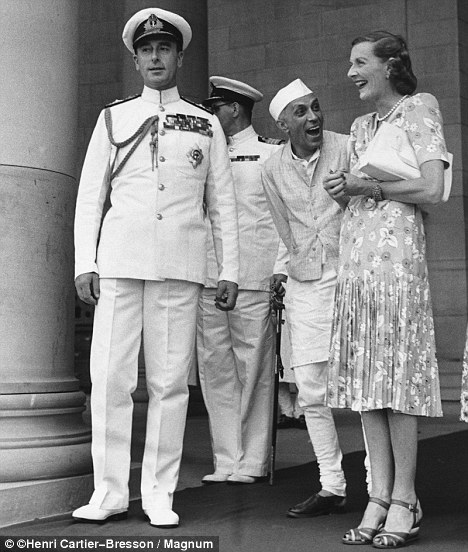
What was remarkable in all this — as seen through Pamela’s eyes — was her father’s dignity and forbearance, as it had been through all the ups and downs of his marriage to Edwina. He remained loyal to the end.
In 1960, aged 58, she died of a stroke on a tour of the Far East for a charity. She had requested to be buried at sea. As the coffin slipped below the water off the south coast of England, Pamela recalls ‘my father standing with tears streaming down his face. It was the only time I had ever seen him weep. He then kissed his wreath (for her) before throwing it into the sea.’
It was the last act of a strange marriage but one which, in its own way, had worked. He had defied the gossip, kept up appearances and kept his family intact, however unconventional the method.
There were apparently no scenes, no public scandal and, best of all, no acrimonious divorce. It was all rather English.
**Lord Louis Mountbatten and his new bride, Edwina, in Charlie Chaplin’s Nice And Friendly (1922). Chaplin made the film as a gift for the newly weds while they were on their honeymoon in America.
#mounbatten#dickie mountbatten#lord mountbatten#quote#edwina#edwina mountbatten#pamela hicks#book#history#india#britain#aristocracy#nobility#nehru#colonialism#marriage
92 notes
·
View notes
Text
Post # 106
Sir Cyril Radcliffe and his bloody lines.
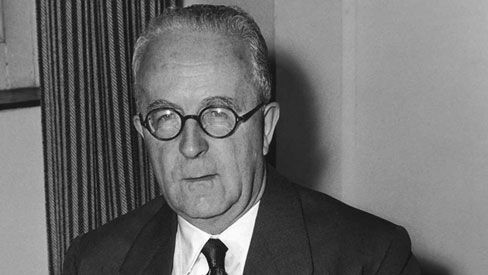
On 12th August, 1947, a British barrister, who had set foot in India only over a month back, who had never been to Asia before and who had never travelled east of Paris, presented to Lord Louis Mountbatten, the last Viceroy of British India, a map with two zigzag lines - one, 553 km long, from Gujarat to the southern tip of Jammu and Kashmir, and the other, 4096 km long, dividing the Bengal presidency into two. His name was Sir Cyril Radcliffe.

Together, these two lines created two new countries - the Republic of India and the Islamic republic of Pakistan (including East Pakistan which later seceded and became Bangladesh).
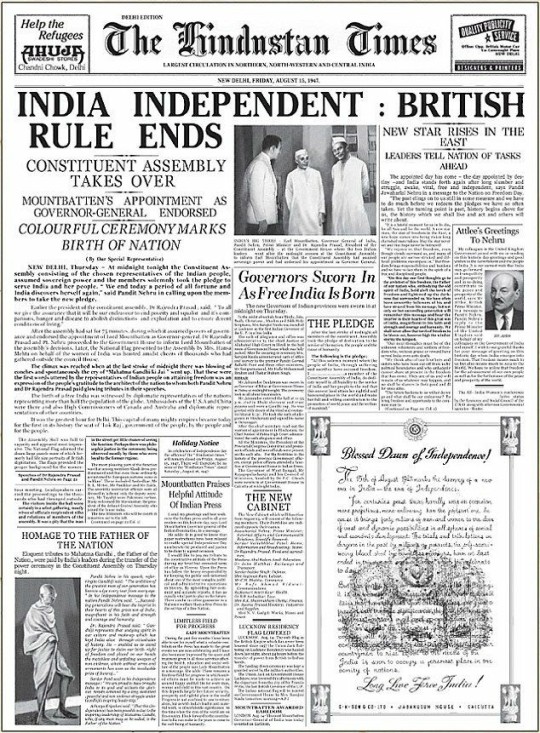
Lord Mountbatten waited five days before publishing the map on 17th August, 1947. He wanted the Independence Day celebrations to be done with - on 14th August for Pakistan and on 15th August for India. He probably expected trouble. Well, he was right. All hell broke loose!
These lines displaced 14.5 million people on either side of them. About 1 million people died in frustration-triggered riotings, pillage, rapes and looting. The scars have still not faded away. India and Pakistan are sworn enemies since. And will probably remain so for some time.
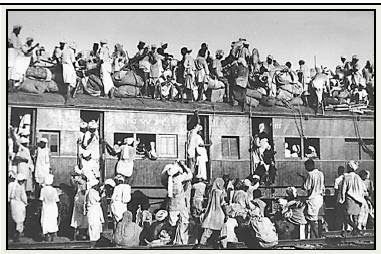
Together, these two lines are called Radcliffe lines and they represent the boundaries between India and Pakistan.
Sir Cyril Radcliffe is said to have been so appalled by the mayhem created by his infamous lines that he refused his salary of 3000 pounds (Forty Thousand rupees). And till his death in 1977, he maintained that he wasn't to blame for this fiasco, he did the best he could, he simply didn't have enough time. Therein lies a tale!
The details of the events that happened are somewhat like this:
After WW II, Great Britain realised that it simply didn't have the resources to control India any more, nor did it have the will to suppress its demands for independence. So, on 20th February, 1947, Prime Minister Clement Atlee announced that Britain would grant India full independence, latest by 30th June, 1948.
In March, 1947, a glamorous royal named Lord Mountbatten was sent to India as its last Viceroy. His mission was simple and clear: To hand over power to Indians, exit with as little damage to British reputation and if possible, avoid partition. But very soon, he realised that India was at a flash point, a truce between Indian National Congress and Muslim League was impossible and Partition was the only way out.
So on 3rd June, he shocked every one by declaring that the British would leave India on 15th August, 1947, about ten months before his deadline, and that the partition would be done based on religion-majority- demographics.
This was called the Mountbatten plan or the 3rd June plan. Mountbatten was clearly in a rush to exit India ASAP.

The British government back home ratified this decision by passing the Indian Independence Act on 18th July, 1947.
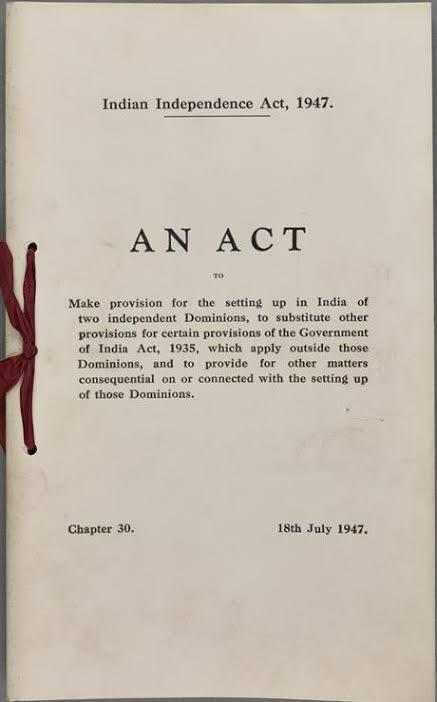
The only thing left to decide was who gets what! Some were simple. Baluchisthan and Sindh had 92% and 73% muslim population respectively. So they went to Pakistan. North West Frontier Province voted in a referendum to join Pakistan. Today, it is called Khyber Pakthunwa.
Princely states were allowed to decide who they wanted to accede to. They could even remain independent if they wanted. So both INC and ML wooed them. Over 560 princely states joined India. Three of them dithered. Junagarh and Hyderabad later joined India and integrated well. The third, Jammu and Kashmir, is a thorn in Indo-Pakistan relationships, even today, decades later. But that's another story. Books can and have been written on it.

All of these were relatively simpler. Punjab and Bengal, each with 54-55% Muslim majority were the tougher ones. Jinnah wanted them both. Nehru and Sardar Patel were adamant. Punjab and Bengal were tough nuts to crack indeed.
Enter Cyril Radcliffe, a complete outsider to this situation. Actually, the selection of Sir Cyril Radcliffe was made because he was a complete outsider and could not be unduly influenced by either the INC or the Muslim League.
He was appointed Joint-Chairman of two boundary committees - one to divide Punjab into East Punjab and West Punjab, and the other to divide Bengal into East Bengal and West Bengal. East Punjab had Hindu majority, West Punjab had Muslim majority. The vice-versa was true in Bengal.
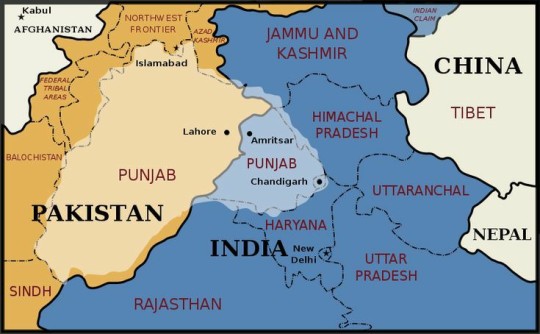
Each committee has two representatives each of INC and Muslim League. No one saw eye to eye. However, they had to distribute village, canal, field and drain - on the basis of religion.
Radcliffe had the responsibility of equitably dividing 450000 sq. km of territory inhabiting 88 million people. And he had just 40 days to do it. Maps were not accurate. Surveying was tough in the July heat in Punjab and Bengal. And Mountbatten would call him twice a day to remind him of his deadline.
So, he bent his back, did the best he could, drew the lines, made the maps, submitted them to Lord Mountbatten - on 12th August, three days ahead of schedule - packed his bags, went back to Britain, burnt his notes, refused his salary and swore never to return to either India or Pakistan. Till the day he died, he knew that he wasn't liked a lot in Punjab or Bengal.
That's the story of Sir Cyril Radcliffe and his blood-smeared Radcliffe lines.

There is a post-script to this story. We are talking about the independence of India and we haven't spoken a word about the guy most responsible for it - Mahatma Gandhi. While all this was happening, the Mahatma grieved in some corner of the country he loved, shocked by the way his dream was turning into a nightmare, not identifying with the "tryst with destiny" that his proteges seemed so cocky about, trying his best to douse the embers of religious hatred in different parts of the country or when tired, retiring to his ashram and spinning his wheel in misery. Less than a year later, an assassin's bullet would rip him apart and he would die with the words "Hey Ram" on his lips.

#cyril Radcliffe#Radcliffe lines#partition#indian independence#pakistan#bangladesh#lord mountbatten#india independence act#jinnah#nehru#sardar patel#east pakistan#india#british india
53 notes
·
View notes
Photo

#otd in Royal History
.
27 August 1979 – Louis Mountbatten, 1st Earl Mountbatten of Burma, English, Governor-General of India (b.1900) was assassinated by the IRA.
.
Mountbatten was a Royal Navy officer & statesman, an uncle of Prince Philip, Duke of Edinburgh, 2nd cousin once removed of Queen Elizabeth II.
.
During the Second World War, he was Supreme Allied Commander, South East Asia Command (1943–1946). He was the last Viceroy of India (1947) & the first governor-general of independent India (1947–1948).
.
From 1954 to 1959, Mountbatten was First Sea Lord, a position that had been held by his father, Prince Louis of Battenberg, some forty years earlier.
.
In August 1979, Mountbatten was assassinated by a bomb that was hidden aboard his fishing boat in Mullaghmore, County Sligo, Ireland, by members of the Provisional Irish Republican Army.
.
.
.
#lestweforget #Britishhistory #LordMountbatten #AdmiraloftheFleet #Royal #Mountbatten #Louismountbatten #RoyalHistory #HistoryFacts #British #History #Admiral #Navy #earlmountbattenofburma #Earl #Royal #royalty #FirstSeaLord #royalnavyofficer #Statesman #Britishroyalty #Britishroyals ##AlliedCommander #Secondworldwar (at Mullaghmore, Sligo, Ireland)
https://www.instagram.com/p/CEZ6m8tpgJb/?igshid=1dbu7g915hsjq
#otd#lestweforget#britishhistory#lordmountbatten#admiralofthefleet#royal#mountbatten#louismountbatten#royalhistory#historyfacts#british#history#admiral#navy#earlmountbattenofburma#earl#royalty#firstsealord#royalnavyofficer#statesman#britishroyalty#britishroyals#alliedcommander#secondworldwar
4 notes
·
View notes
Text
#OTD in 1979 – A Provisional Irish Republican Army bomb kills British retired admiral Lord Mountbatten and three others while they are boating on holiday off the coast in Co Sligo.
An IRA bomb kills the Queen’s cousin Lord Louis Mountbatten in Co Sligo.
Mountbatten regularly holidayed in the West of Ireland. The bomb exploded on his boat some minutes after he and family friends had departed the little port of Mullaghmore. Mountbatten’s grandson Nicholas, 14, and fifteen year old local, Paul Maxwell, 15, employed as a boat boy were also killed. Another passenger, the Dowager…
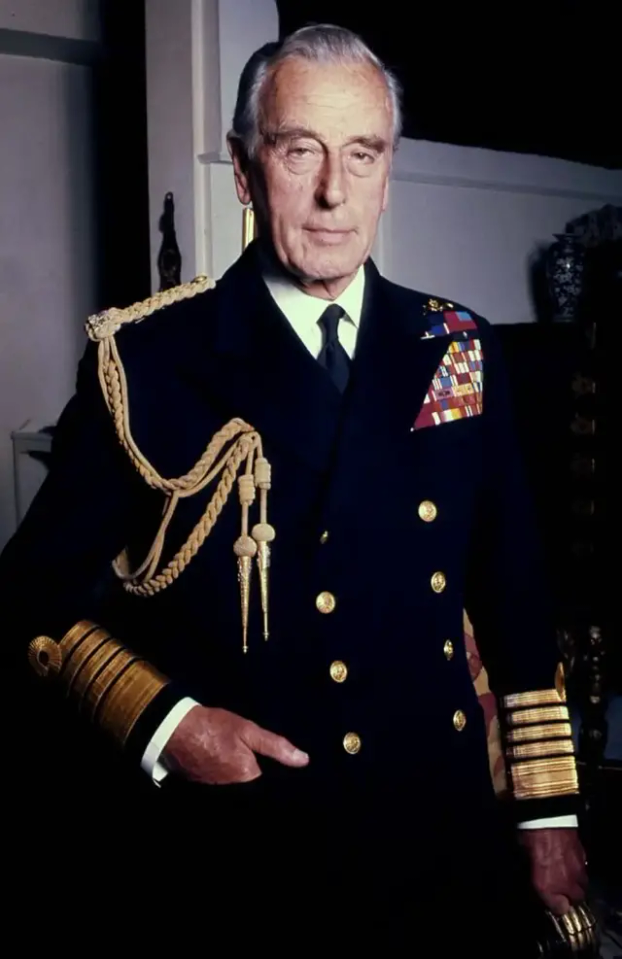
View On WordPress
#Assassination of Lord Louis Mountbatten#Co. Sligo#England#English History#Good Friday Agreement#History#IRA#Ireland#Irish History#Mullaghmore#Queen Elizabeth II#Thomas McMahon
4 notes
·
View notes
Photo
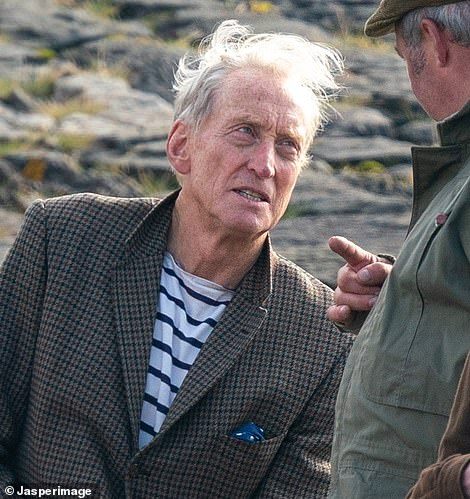






In character: Charles Dance transformed into Lord Louis Mountbatten of Burma as he filmed his assassination for The Crown's third series in Keiss Harbour, Scotland, on Sunday
source: dailymail
#CD#charles dance#the crown#series 3#filming#keiss harbour#scotland#lord louis mountbatten#a remarkable man
26 notes
·
View notes
Text
More intelligence information coming out
PERV’ DOSSIER Prince Charles’ mentor Lord Mountbatten was ‘a homosexual with a perversion for young boys’, FBI files claim
Tristan Grove
18 Aug 2019, 2:27Updated: 18 Aug 2019, 8:05
NEWLY unearthed FBI files describe Prince Charles’s mentor, Lord Mountbatten, as “a homosexual with a perversion for young boys”.
The decorated war hero was seen as a father figure to the young Charles, his great-nephew, and is even credited with introducing his father to Queen Elizabeth.
The Duke of Wales was mentored by Mountbatten as he grew up, and described him as “the grandfather I never had”.
Mountbatten - who also features in The Crown on Netflix - even coached his great-nephew on his love life.
As the last viceroy of India, Mountbatten oversaw the British withdrawal and eventually became the chief of defence until 1965.
The military man was also well-known for his sexual appetites, sparked in part by his own comment: “Edwina and I spent all our married lives getting into other people’s beds.”
‘LOW MORALS’
More is known about his wife Edwina’s extra-marital affairs, but a recently obtained secret dossier dating back 75 years describes them both as “persons of extremely low morals”.
British historian Andrew Lownie used freedom of information laws to source the files, and quotes them in his new biography of the famous couple.
In the dossier, an aristocratic source close to them, interviewed by the FBI in the 1940s, described them as “persons of extremely low morals”.
Another source in the FBI files claimed that Mountbatten’s private life made him “an unfit man to direct any sort of military operations.”
In Lownie’s book, The Mountbattens: their Lives & Loves, Ron Perks, who was Mountbatten’s driver in Malta in 1948, also breaks his silence.
He tells how Mountbatten had one favoured destination, the Red House near Rabat, which “was an upmarket gay brothel used by senior naval officers”, which he had not realised at the time.
Homesexual acts were banned in the UK until 1967, and many memos about Mountbatten’s sexuality have been edited or destroyed since.
‘PERVERSION’
Disturbing allegations also claim he had an interest in underage boys.
Elizabeth de la Poer Beresford, Baroness Decies, when interviewed about another matter, had mentioned being an intimate of Queen Elizabeth, Queen Mary and their ladies-in-waiting.
The first FBI files date back to February 1944, soon after Mountbatten had become supreme allied commander of southeast Asia.
It reads: “She states that in these circles Lord Louis Mountbatten and his wife are considered persons of extremely low morals.
“She stated that Lord Louis Mountbatten was known to be a homosexual with a perversion for young boys.
"In Lady Decies’ opinion he is an unfit man to direct any sort of military operations because of this condition. She stated further that his wife Lady Mountbatten was considered equally erratic.”
Mr Lownie believes US spies began compiling intelligence on Mountbatten’s private life after he was made supreme allied commander of Southeast Asia during the Second World War.
It’s not known if the material was passed to the British government.
Mountabatten was assassinated in an IRA bomb attack in 1979, that also killed Nicholas, John’s mother Lady Brabourne and a 15-year-old crew member, Paul Maxwell.
The book, The Mountbattens, will be published on August 22
GSTQAOBC 🇨🇦
Thank you PG💜💜💜💜💜💜💜
https://www.thesun.co.uk/news/9745399/lord-mountbatten-fbi-dossier-prince-charles/
52 notes
·
View notes
Text
The Shining, Part One: Redrum is the New Black, Mrs. Torrance
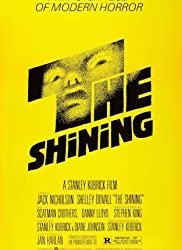
Before we go any further, I am very aware that The Shining was released in 1980, and thus should be exempt from the perusing of a blog dedicated to 1970s horror architecture. It’s probably the most-mentioned movie from friends asking me to cover a film, and I’ve been pretty dogged about sticking to my script with 1970s movies. But maybe I’m feeling generous, as we’re about to put this last decade to bed (and I never really figured out what to call it - the Twenty-Tens? Nope. The Tens? I don’t think so). Anyway, The Shining is one of my earliest favorite horror flicks, based on a book from one of my earliest favorite horror writers. And technically, Stanley Kubrick shot the bulk of his adaption of Stephen King’s 1977 book in the ‘70s. In fact, it could be argued (and will be in fact be argued forthwith) that The Shining is the last of the great 70s horror movies, and very different in tone and setting from what characterizes most 1980s horror films. What is this criteria, you ask? I’m so glad you asked!
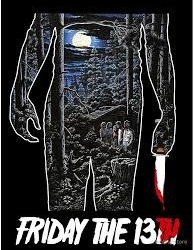
The great 1970s architecture horror flicks tend to be set on stately country manors (most of The Omen, the beginning of Don’t Look Now), stylish city apartments/lofts (Audrey Rose, Sisters, Profondo Rosso), or otherwise sophisticated urban or bucolic location, such as a dance academy (Suspiria). In contrast, many of the iconic 1980s horror flicks are set in manufactured wilderness (the Friday the 13th and Sleepaway Camp franchises), or safe suburbia (the Poltergeist and Nightmare on Elm Street franchises). These are spaces for children and teenagers, with nary a cocktail tray or curated window treatment in view. I’m pretty sure the transformation occurred because the target audience shifted to that age demographic, but it also does speak of the 1980s flavor of paranoia versus the 1970s psychosis. The 1980s were all about outsiders (slashers/monsters) attacking safe traditional spaces, where the settings of 1970s horror flicks were somewhat sinister themselves in their old-world elegance.

And speaking of sinister, Kubrick and cinematographer John Alcott did a wonderful stitch-up with the opening vista. Ariel shots from a helicopter above Going-to-the-Sun Road in Montana’s Glacier National Park are cobbled together with a wide view of Oregon’s Timberline Lodge, which served as the exterior shots of the fictional Overlook Hotel. I shall pause here to note that these endeavors, both park and hotel, exist courtesy of FDR’s Works Progress Administration. I first visited Timberline Lodge almost exactly 18 years ago while spending the Thanksgiving holiday in Hood River with my sis, bro-in-law, and nephew, and got to visit Glacier for the first time this past September (a lovely side trip after my brothers-in-laws’ wedding), and I gotta admit, I find nothing scary about democratic socialism. The WPA was responsible for providing work and hope to a lot of desperate people during the Great Depression, and leaves as its legacy some of our loveliest landmarks in America.
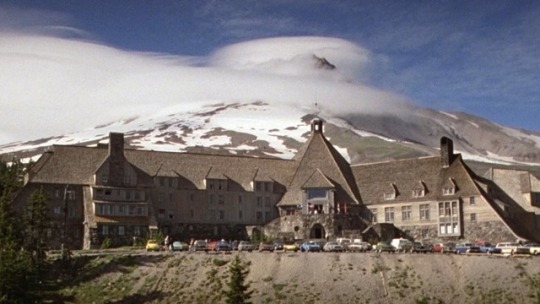
In contrast, the Stanley Hotel in Estes Park, Colorado was Stephen King’s inspiration for the Overlook. The Stanley was built by Freelan Oscar Stanley, of Stanley Steamer fame. Stanley the Steamer decided the local accommodations (where he fully recuperated from tuberculosis) were a bit too “rustic,” and the social scene too “relaxed,” so he built himself an exclusive enclave for the rich. Bully for you, Freelan.

The Overlook Hotel existed mostly as a set in Elstree Studio in England. Kubrick and production designer Roy Walker purposely set out to make the Overlook an amalgamation of bits and pieces of real hotels, rather than giving it one single design aesthetic. The red men's bathroom was modeled on a men's room in the Biltmore Hotel in Arizona (often credited to Frank Lloyd Wright, but in fact designed by his student Albert Chase McArthur).

The Colorado Lounge (that serves as Jack’s writing studio) was based on the lounge of the Ahwanee Hotel in the Yosemite Valley. The set of the Colorado Lounge ended up burning down; apparently, the fire was caused by the intense wattage of the set lights needed to make the interiors appear day-lit from sun reflected off the snow.

The Overlook also does not follow any laws of physics: rooms that should be wholly interior have windows, and hallways and floors don’t make any sense directionally-speaking. This disorientation helps to build the feeling of disquiet and unease in the early scenes. There’s a really worthwhile analysis of this and other Kubrick krazy-ness on YouTube by Rob Ager.
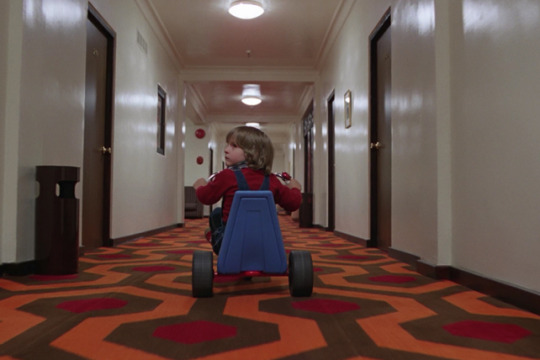
Before we break, here’s one last thing to chew on: the iconic carpet that Danny spins down on his Big Wheel was created by David Nightingale Hicks, the hot designer of the Swinging Sixties. The carpet wasn’t commissioned for the film, but in fact was in existence for about a decade prior. That particular pattern of brown, magenta, and orange is now licensed as Hick’s Hexagon, and you can buy a square for your own pad. Or (the more affordable option) you could just get a pair of socks. Kubrick was already familiar with Hicks’ work, though. The filmmaker featured the Chelsea Drugstore in a Clockwork Orange, a space designed by Hicks and the architectural firm he worked with (Garnett Cloughley Blakemore). Here’s a weird rabbit hole I fell down while researching: Hicks was married to Lady Patricia Mountbatten, the daughter of Louis Mountbatten, aka the First Earl Mountbatten of Burma, aka the last British Viceroy of India, and the man who oversaw the partition of that country into a separate Muslim state of Pakistan. It can be reasonably argued that Mountbatten’s clumsy transition to partition hastened the deaths of thousands during that period, as Hindus and Muslims scrambled to establish themselves in friendly territory. The bloodshed continues today in the two countries’ battle for control of Kashmir. Maybe something to ponder in concert with the image of an ocean of blood spilling from the elevator onto the brightly patterned floor? Another fun fact: Lord Mountbatten was assassinated by the Provisional Irish Republican Army 40 years ago.
Well, um, on that cheerful note, here’s to 2020! To be continued...
4 notes
·
View notes
Text
[ad_1]
Soviet President Mikhail Gorbachev met Queen Elizabeth II in 1989.London: From a string of US presidents to Lady Gaga, Queen Elizabeth II met main political and inventive personalities from across the globe throughout her record-breaking time on the throne. Some had been despised dictators, others world-famous guitarists she made well mannered dialog with. Regardless of the personalities, she at all times saved her composure.Here are a few of her well-known conferences: - West to East -After her accession in 1952, the queen met all sitting US presidents apart from Lyndon B Johnson. That spans 14 heads of state, from Dwight D Eisenhower to Joe Biden. During the Cold War, nevertheless, her conferences with leaders from the Soviet bloc had been few and much between.In 1956, Elizabeth acquired Soviet chief Nikita Khrushchev, who was overseeing a political thaw after changing Joseph Stalin.But it might be greater than three many years later, in 1989, that Mikhail Gorbachev can be invited for an viewers. It got here after he launched a coverage of "perestroika" (restructuring) which led to the collapse of the Soviet Union.The queen was the primary British monarch in historical past to go to Russia, when she was hosted by president Boris Yeltsin in 1994.Russian President Vladimir Putin met the queen throughout a state go to to Britain in 2003.- War and peace -Mother Teresa and Pakistani schooling activist Malala Yousafzai had been simply two of the Nobel Peace Prize laureates the queen met.She had a very hot relationship with South Africa's anti-apartheid hero Nelson Mandela, one of many few who known as her by her first identify.But the pinnacle of state additionally acquired the leaders of a number of the world's most repressive regimes.They included Zaire's Mobutu Sese Seko, who paid a state go to to Britain in 1973 and Zimbabwean president Robert Mugabe in 1994.Romania's dictator Nicolae Ceausescu was invited by the federal government -- and to the queen's reported displeasure -- in 1978.She is claimed to have hidden in a bush within the grounds of Buckingham Palace whereas strolling her corgis to keep away from speaking to him.- Historic handshake -On June 27, 2012 the British monarch exchanged a historic handshake in Belfast with Martin McGuinness, a former Irish Republican Army paramilitary commander who had change into quantity two within the Sinn Fein occasion, which doesn't recognise her sovereignty over Northern Ireland.It was a gesture that might have been unimaginable just some years earlier amid the bitterness of the lethal battle in Northern Ireland.The IRA had assassinated her relative, Lord Louis Mountbatten, in 1979."Hello, are you well?" McGuinness -- by then deputy first minister within the power-sharing authorities in Belfast -- requested the monarch."Thank you very much. I am still alive anyway," she responded.The photograph of their handshake, which got here 14 years after the Good Friday peace accords that largely ended the three many years of battle, was beamed world wide as a historic second of reconciliation.- Artistic encounters -The monarch additionally met a number of the greatest artists of the twentieth and twenty first centuries: opera singer Maria Callas; actors Marilyn Monroe, Charlie Chaplin, Elizabeth Taylor and Brigitte Bardot; ballet dancer Rudolf Nureyev; and singer Frank Sinatra.In her autobiography, British crime author Agatha Christie wrote that purchasing a automobile and eating with the queen at Buckingham Palace had been the 2 most fun moments of her life.She remembered "her kindness and easiness in talking" and described her as "so small, and slender, in her simple dark red velvet gown with one beautiful jewel".- Spice up your life -From Michael Jackson, when he was nonetheless an adolescent, to Lady Gaga and Madonna, she additionally encountered a number of the world's greatest pop stars, generally giving rise to amusing scenes.In 1997, with completely coiffed hair and white
gloves, she was photographed shaking arms with the Spice Girls, carrying thigh-high break up robes and exhibiting off plunging necklines.In 2005, at a pop star bash at Buckingham Palace, the queen requested guitarist Eric Clapton, "Have you been playing a long time?"."It must be 45 years now," replied Clapton, 59 on the time. - Bond lady -Elizabeth additionally crossed paths with fictional characters.In 2012 she took half in a spoof video with James Bond star Daniel Craig by which she appeared to parachute into the opening ceremony of the London Olympics.She met her fictional double, actress Helen Mirren, on a number of events. Mirren gained an Oscar for having performed the title function in "The Queen" in 2006.The actual monarch made Mirren a dame in 2003.(Except for the headline, this story has not been edited by NDTV employees and is printed from a syndicated feed.)
[ad_2]
Source link
0 notes
Text
#OTD in 1979 – A Provisional Irish Republican Army bomb kills British retired admiral Lord Mountbatten and three others while they are boating on holiday off the coast in Co Sligo.
#OTD in 1979 – A Provisional Irish Republican Army bomb kills British retired admiral Lord Mountbatten and three others while they are boating on holiday off the coast in Co Sligo.
An IRA bomb kills the Queen’s cousin Lord Louis Mountbatten in Co Sligo.
Mountbatten regularly holidayed in the West of Ireland. The bomb exploded on his boat some minutes after he and family friends had departed the little port of Mullaghmore. Mountbatten’s grandson Nicholas, 14, and fifteen year old local, Paul Maxwell, 15, employed as a boat boy were also killed. Another passenger, the Dowager…
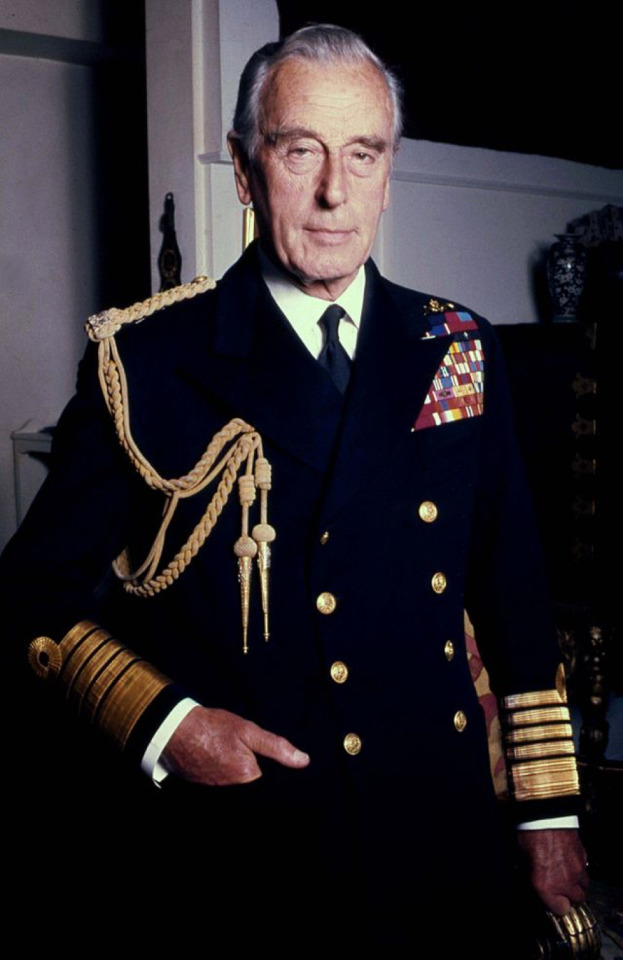
View On WordPress
#Assassination of Lord Louis Mountbatten#Co. Sligo#England#English History#Good Friday Agreement#History#IRA#Ireland#Irish History#Mullaghmore#Queen Elizabeth II#Thomas McMahon
6 notes
·
View notes
Text
Events 8.27
410 – The sacking of Rome by the Visigoths ends after three days.
1172 – Henry the Young King and Margaret of France are crowned junior king and queen of England.
1557 – The Battle of St. Quentin results in Emmanuel Philibert becoming Duke of Savoy.
1593 – Pierre Barrière failed an attempt to assassinate Henry IV of France.
1689 – The Treaty of Nerchinsk is signed by Russia and the Qing Empire (Julian calendar).
1776 – Battle of Long Island: In what is now Brooklyn, New York, British forces under General William Howe defeat Americans under General George Washington.
1793 – French Revolutionary Wars: The city of Toulon revolts against the French Republic and admits the British and Spanish fleets to seize its port, leading to the Siege of Toulon by French Revolutionary forces.
1798 – Wolfe Tone's United Irish and French forces clash with the British Army in the Battle of Castlebar, part of the Irish Rebellion of 1798, resulting in the creation of the French puppet Republic of Connacht.
1810 – Napoleonic Wars: The French Navy defeats the British Royal Navy, preventing them from taking the harbour of Grand Port on Île de France.
1813 – French Emperor Napoleon I defeats a larger force of Austrians, Russians, and Prussians at the Battle of Dresden.
1828 – Brazil and Argentina recognize the sovereignty of Uruguay in the Treaty of Montevideo
1832 – Black Hawk, leader of the Sauk tribe of Native Americans, surrenders to U.S. authorities, ending the Black Hawk War.
1859 – Petroleum is discovered in Titusville, Pennsylvania leading to the world's first commercially successful oil well.
1881 – The Georgia hurricane makes landfall near Savannah, Georgia, resulting in an estimated 700 deaths.
1883 – Eruption of Krakatoa: Four enormous explosions destroy the island of Krakatoa and cause years of climate change.
1893 – The Sea Islands hurricane strikes the United States near Savannah, Georgia, killing between 1,000–2,000 people.
1896 – Anglo-Zanzibar War: The shortest war in world history (09:02 to 09:40), between the United Kingdom and Zanzibar.
1914 – World War I: Battle of Étreux: A British rearguard action by the Royal Munster Fusiliers during the Great Retreat.
1915 – Attempted assassination of Bishop Patrick Heffron, bishop of the Diocese of Winona by Rev. Louis M. Lesches.
1916 – World War I: The Kingdom of Romania declares war on Austria-Hungary, entering the war as one of the Allied nations.
1918 – Mexican Revolution: Battle of Ambos Nogales: U.S. Army forces skirmish against Mexican Carrancistas in the only battle of World War I fought on American soil.
1922 – Greco-Turkish War: The Turkish army takes the Aegean city of Afyonkarahisar from the Kingdom of Greece.
1927 – Five Canadian women file a petition to the Supreme Court of Canada, asking, "Does the word 'Persons' in Section 24 of the British North America Act, 1867, include female persons?"
1928 – The Kellogg–Briand Pact outlawing war is signed by fifteen nations. Ultimately sixty-one nations will sign it.
1933 – The first Afrikaans Bible is introduced during a Bible Festival in Bloemfontein.
1939 – First flight of the turbojet-powered Heinkel He 178, the world's first jet aircraft.
1942 – First day of the Sarny Massacre, perpetrated by Germans and Ukrainians.
1943 – World War II: Japanese forces evacuate New Georgia Island in the Pacific Theater of Operations during World War II.
1943 – World War II: Aerial bombardment by the Luftwaffe razes to the ground the village of Vorizia in Crete.
1956 – The nuclear power station at Calder Hall in the United Kingdom was connected to the national power grid becoming the world's first commercial nuclear power station to generate electricity on an industrial scale.
1962 – The Mariner 2 unmanned space mission is launched to Venus by NASA.
1964 – South Vietnamese junta leader Nguyễn Khánh enters into a triumvirate power-sharing arrangement with rival generals Trần Thiện Khiêm and Dương Văn Minh, who had both been involved in plots to unseat Khánh.
1971 – An attempted coup d'état fails in the African nation of Chad. The Government of Chad accuses Egypt of playing a role in the attempt and breaks off diplomatic relations.
1975 – The Governor of Portuguese Timor abandons its capital, Dili, and flees to Atauro Island, leaving control to a rebel group.
1979 – The Troubles: Eighteen British soldiers are killed in an ambush by the Provisional Irish Republican Army near Warrenpoint, Northern Ireland, in the deadliest attack on British forces during Operation Banner. An IRA bomb also kills British royal family member Lord Mountbatten and three others on his boat at Mullaghmore, Republic of Ireland.
1980 – A massive bomb planted by extortionist John Birges explodes at Harvey's Resort Hotel in Stateline, Nevada after a failed disarming attempt by the FBI. Although the hotel is damaged, no one is injured.
1982 – Turkish military diplomat Colonel Atilla Altıkat is shot and killed in Ottawa. Justice Commandos of the Armenian Genocide claim to be avenging the massacre of 11⁄2 million Armenians in the 1915 Armenian Genocide.
1985 – Nigeria's military government is overthrown by another clique of army officers.
1991 – The European Community recognizes the independence of the Baltic states of Estonia, Latvia and Lithuania.
1991 – Moldova declares independence from the USSR.
2003 – Mars makes its closest approach to Earth in nearly 60,000 years, passing 34,646,418 miles (55,758,005 km) distant.
2003 – The first six-party talks, involving South and North Korea, the United States, China, Japan and Russia, convene to find a peaceful resolution to the security concerns of the North Korean nuclear weapons program.
2006 – Comair Flight 5191 crashes on takeoff from Blue Grass Airport in Lexington, Kentucky bound for Hartsfield–Jackson Atlanta International Airport in Atlanta. Of the passengers and crew, 49 of 50 are confirmed dead in the hours following the crash.
2009 – Internal conflict in Myanmar: The Burmese military junta and ethnic armies begin three days of violent clashes in the Kokang Special Region.
2011 – Hurricane Irene strikes the United States east coast, killing 47 and causing an estimated $15.6 billion in damage.
0 notes